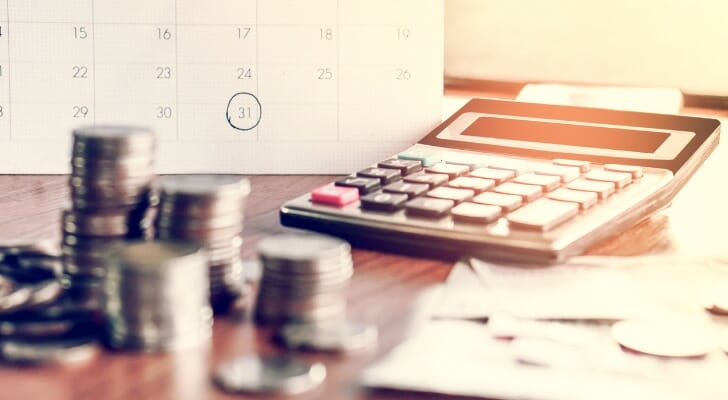There’s about $1.8 trillion in client assets invested in target-date funds (TDFs), according to Morningstar. In fact, it’s likely your 401(k) or IRA offers a target-date fund as an investment option. This makes TDFs extremely accessible retirement savings options. The beauty of these funds is that there’s a plethora of different investing strategies available, allowing you to pick which one you prefer. But, like anything else in finance, these investments don’t come without their pitfalls.
Do you have questions about saving for retirement? Speak with a financial advisor today.
What Is a Target-Date Fund?
A target-date fund works like a mutual fund in that it offers a one-stop shop for retirement investing. As their name indicates, target-date funds are collections of investments that are designed to mature at a certain time. You’ll pick your fund based on your intended retirement date, as they are usually divided into multi-year intervals. When it comes to investments, target-date funds typically invest in a mix of stocks, bonds, mutual funds, exchange-traded funds (ETFs) and more. In general, as you near your retirement date, the fund will adjust its asset allocation to become more conservative.
Target-date funds are increasing in popularity every year. Employers are even integrating target-date funds into their default retirement plan investment choices for new workers. But is this “set it and forget it” option a smart choice? The answer to this question depends on the target-date fund in which you ultimately invest.
What to Look for in a Target-Date Fund

When selecting a target-date fund to invest in, the first step is to learn the fund’s investing strategy. Research the different target-date fund options available to you, and compare different fund managers’ investing strategies. This is a vital step, as the professional management that target-date funds offer can sometimes have a downside. On one hand, someone who likely has ample investing experience is taking care of your investments. But on the flip side, these managers have no personal connection to you like, say, a financial advisor would.
If this style works for you, try to evaluate whether or not a fund’s asset allocation is in line with your preferences. Funds will usually invest in a few types of securities, namely domestic and international stocks, bonds and fixed-income securities, ETFs and more. Generally speaking, a fund that’s heavy in stocks is high-risk, high-reward, whereas a fund with mostly fixed-income is traditionally low-risk, low-reward. Beyond this, take a look at the industries and markets that a fund centers its investments around.
It’s also imperative to study a fund’s “glide path” when doing your research. This term refers to how the fund’s investments will change over time, or, more specifically, how it will make its transition from riskier to safer as you near retirement. For the most part, you want to decrease exposure to stocks as you prepare to withdraw money in retirement, though this isn’t necessarily the philosophy of every fund. Lastly, the performance history of any fund is likely to be one of its main indicators for future success.
Like any investment, fees play a part in how profitable a target-date fund can be. Fee schedules vary wildly from company to company, as no fund invests in the same securities. Make sure you take the time to compare costs before you buy in.
Pros and Cons of Target-Date Funds
If you’re unwilling or unable to take the time to pick investments, target-date funds can be a viable Plan B. You get easy access to a diversified portfolio, which will be automatically rebalanced for you. This hands-free style is backed by real investing knowledge, though strong returns are never guaranteed. The ability to pick a fund that invests according to the year you plan to retire is also an extremely practical perk.
On the downside, target-date funds are not immune to typical market shifts. Just because investment professionals control these funds doesn’t mean that declines are impossible. As a matter of fact, a 2018 report from Reuters indicated that some of the largest funds experienced drop-offs of more than 1.00%.
Examples of Target-Date Funds
Many large companies exist in the target-date fund market, including Vanguard and Fidelity. Remember that although these brands attempt to remain on target with their asset allocations, there is some variance. Here are a few of the largest retirement-centric target-date funds available today:
Target-Date Fund Options
| Fund Name | Target Asset Allocation |
| Vanguard Target Retirement Income Fund | 50% stocks and 50% bonds |
| Fidelity Freedom® Index Income Fund | 72% bonds, 10% short-term debt, 10% domestic equities and 8% international equities |
| TIAA-CREF Lifecycle Retirement Income Fund | 51% fixed-income, 33% stocks, 10%inflation-protected assets and 6% direct real estate |
Should I Invest in a Target-Date Fund?

Target-date funds are as simple and easy as any retirement savings product you’ll come across. They provide effortless access to professional money management, though you do lose the personal side of things. However, companies design target-date funds to be your sole retirement investment, which takes away the stress of building your own portfolio.
The potential benefits aside, target-date funds aren’t for everyone. Their set-it-and-forget-it approach could make some investors feel out of control of their savings. And there are other portfolio strategies can that can surpass the returns of these funds. In the end, the choice of whether or not to invest in a target-date fund is personal, and therefore your internal considerations must be of paramount importance.
Bottom Line
A target-date fund can take the guesswork out of saving for retirement over the long term. Their ability to adjust your portfolio’s asset allocation as you near retirement can play a major role in not only growing your assets, but maintaining them and staving off losses. On the flip side, taking away your ability to make individual investment decisions in your portfolio may leave you feeling a bit out of control of your own destiny.
Tips for Your Retirement Savings
- Although Social Security likely won’t afford you enough money to fund your entire retirement, it can help quite a bit. In turn, it’s important to include your projected Social Security earnings in your retirement savings projections. To get a glimpse as to what you can expect, visit the SmartAsset Social Security calculator.
- Financial advisors deal with many areas of finance, including investing, financial planning and more. You may want a financial advisor to aid you in your retirement savings journey. Finding a qualified financial advisor doesn’t have to be hard. SmartAsset’s free tool matches you with up to three financial advisors who serve your area, and you can interview your advisor matches at no cost to decide which one is right for you. If you’re ready to find an advisor who can help you achieve your financial goals, get started now.
Photo credit: ©iStock.com/Doucefleur, ©iStock.com/undefinedundefined, ©iStock.com/AndreyPopov
